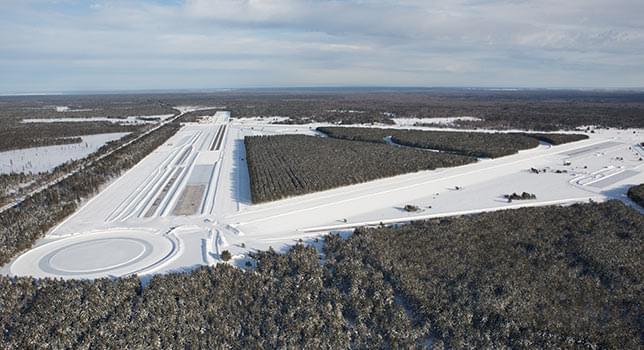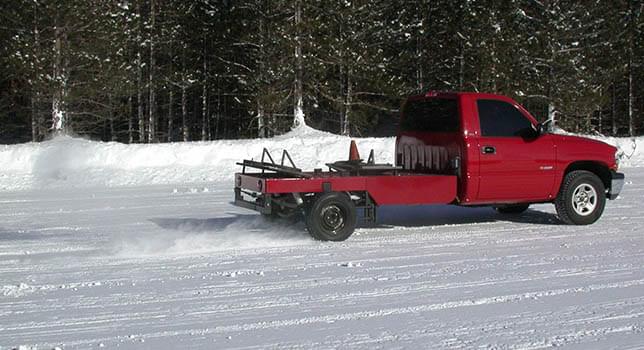“The
LSSU engineering faculty are proud of the senior project experience that we offer to our
students,” said Dr. David Baumann, professor of electrical and computer engineering and the team’s faculty

advisor. “Not only do they have the opportunity to apply what they have already learned to solving a real-world problem, but additionally they sharpen their soft skills such as technical writing, communicating with other engineers, and presenting ideas to a mixed audience along the way. This year, Smithers offered an ideal project that presented numerous technical challenges, involved detailed design work, and resulted in a functioning prototype.”
The Challenge
The SWTC uses only
natural snow for its testing surfaces, which means testing data is subject to natural variation. All tracks are groomed around the clock to ensure as much consistency as possible, but conditions must be measured and recorded when testing occurs. Being able to account for these variations is key to producing consistent, reliable testing data about tire performance.
Two especially important parameters are snow compression and shear characteristics, both of which can have an impact on tire performance. However, existing methods for measuring both are manual, labor and time intensive, and difficult to repeat.
“Snow compression and shear characteristics are not usually required by on-vehicle snow testing standards—or measured at all,” said Eric Pierce, Principal Engineer, SWTC and
Treadwell Research Park, Smithers. “However, understanding these characteristics would allow us to build a model to understand the natural variability of the longitudinal traction coefficient that occurs within the standardized temperature and snow compaction, which would help us capture more consistent, reliable, and repeatable data. In other words, understanding snow compression and shear characteristics would give us—and our clients—deeper insight into why tires behave differently during different stages of the winter season, insight that no other proving ground can provide.”
Pierce, Mills, and the Smithers team asked the LSSU students to develop a better method for measuring the snow compression and shear characteristics of compacted snow surfaces at the winter test track. The students visited Pierce and Jonah Mills, Engineering Assistant, Smithers, on site at the SWTC to learn about the track, see the traction trucks, watch videos of the traction testing process, and review sample data before they got started.
The Project
The team designed and built an automated device to meet Smithers’ needs. The device consists of two main
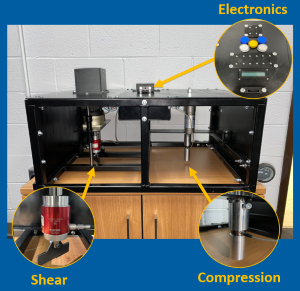
measuring subsystems:
- A compression measuring subsystem. A linear actuator vertically pushes a load cell coupled work head into the snow surface and measures normal force as a function of time and depth into the snow surface.
- A shear measuring subsystem. A linear actuator, paired with a rotary motor and torque sensor, cuts into the surface and rotates, measuring the torque required to shear the snow as a function of time and degrees rotated.
The work was shared among all six students, who called themselves
Team SCRAPE (Shear Compression Reading And Predicting Electronics):
- Damian Cook (Computer Engineering) programmed the device to ensure robust and efficient operations. He executed the interfacing of the Arduino Mega microcontroller board to both the compression and shear subsystems, including their respective motors, linear actuators, and sensors.
- Jack Izzard (Mechanical Engineering), Ryan Reiniche (Mechanical Engineering), and Bethany Roberts (Manufacturing and Engineering Technology) teamed up for the research, design, and implementation of the device’s mechanical systems. Their work included FEA analysis, 3D modeling, welding, and fabrication. “It was really neat to see something go from an idea to a CAD model, and then finally to a working device,” said Izzard.
- Ian Sweet (Computer Engineering) designed the device’s electronic subsystems and PCBs to control the flow of power to the device’s respective subsystems without excessive wires. He also designed the device’s easy-to-use interface. “The relief and pride I felt once the device ran its whole measurement sequence start to end without a hitch perhaps cannot be articulated,” said Sweet.
- Riley Traver (Manufacturing and Engineering Technology) machined many critical device components, including the compression and shear work heads, component adaptors, and anchoring brackets. He also developed a comprehensive user manual for the team at SWTC.
Team SCRAPE also developed a ten-point list of acceptance criteria for the device. According to their requirements, the device must:
- Take separate measurements for compression and shear. The compression measurements must be within a tolerance of +/- 0.1 lbf, and shear measurements must be within +/- 0.1 lbf/in.
- Output shear force/torque as a function of rotation (degrees) and time (seconds), and output normal load as a function of depth (inches) and time (seconds).
- Function on snow compliant with the ASTM F1805-20 standard. This standard describes a specific compacted snow surface, primarily used for testing snow tires, that measurements must occur on.
Other acceptance criteria include size, weight, and power specifications and operations requirements.
Because the device was finished after the winter season, the team had to get creative when it came to testing its efficacy. They tested the device on old snow that Pierce and Mills had saved in a freezer, then progressed to a sand volleyball court. When the sand tests succeeded, they progressed to hard-packed dirt with grass. “I expected failure at that point, but it worked,” said Pierce.
Learnings and Reflection
“Reaching the end of any project, let alone one this large, is not easy. In the beginning, the task seemed very daunting, and there were many aspects of both project management and engineering concepts that we needed to learn on the fly,” said Cook. “Looking back, I'm proud to have held strong throughout the process and been tenacious enough to see it through. Also, I think the potential for real positive impact from this project is very exciting, and I'm glad to be able to be a part of it.”
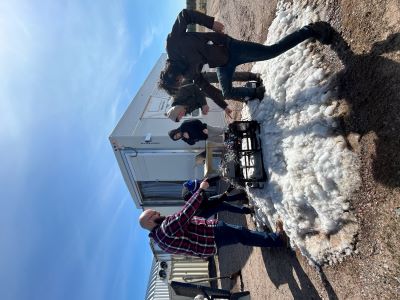
“Monitoring and recording snow parameters throughout the winter testing season is very important for understanding the impact of changing conditions on tire test data,” said Pierce. “With this new device, the SWTC team can capture shear and compression data and compare it to data from our control tires, which may lead to further developments in the field of tire traction testing. We are incredibly proud of what Team SCRAPE has accomplished with this project, and both Smithers and our customers will reap the benefits of their ingenuity for years.”
The device has potential beyond the SWTC. While Team SCRAPE’s device was designed for snow, it could be used to assess soil and offroad surfaces as well. Other possible applications include ski slope analysis and avalanche research.
The students gained significant experience building the device and shared stories of important lessons learned in the process.
“LSSU’s senior capstone project is truly singular in the lengths they go to simulate an immersive industry experience from start to finish, and I take the most pride in the newfound sense of confidence I have moving forward from the project,” said Sweet. “The most valuable takeaway, going forward into industry, would be recognition of my own accountability. It is okay to make mistakes, but you have to be accountable to your missteps and communicate with your team.”
“Communication and mutual understanding within a group project is key to the success of that project. Building this device gave me an understanding of how a project is run and how to navigate varying opinions and beliefs within a team,” said Reiniche. “Working with the Smithers team has been a blast, and I'm proud we were able to give them a working product.”
Sweet agreed. “Working with Eric Pierce, Jonah Mills, and the crew at Smithers was a highlight of the project for me. Eric was extremely attentive, on several occasions offering to come in to help assemble things as he had the time. His genuine interest and commitment to see a working instrument inspired me to keep working to find any solutions I could to see everything through.”
Smithers has a long history of partnering with universities to support students’ engineering education by way of real-world experience. Past projects have supported students at the
University of Akron and Michigan State University School of Packaging.
“Smithers has a ‘big picture’ view of the valuable experience they provide and their contribution to the engineering education of students,” said Dr. Baumann.
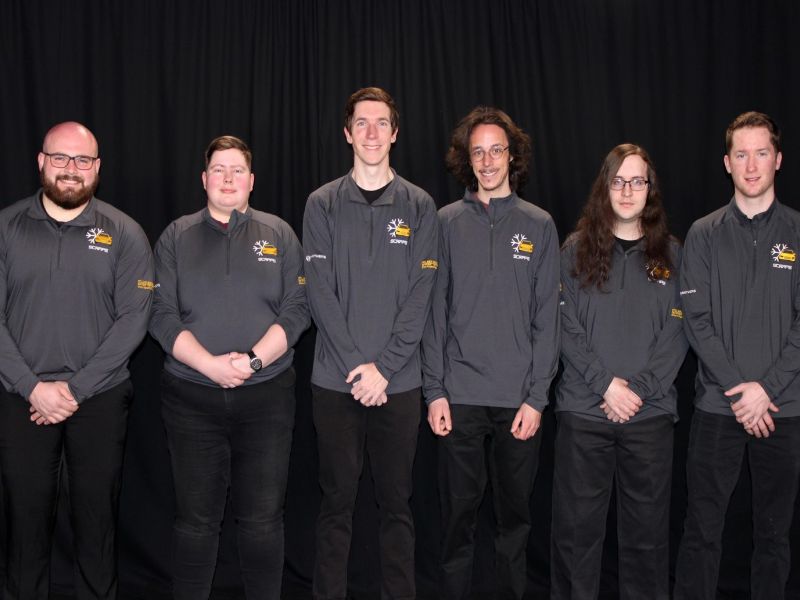
 advisor. “Not only do they have the opportunity to apply what they have already learned to solving a real-world problem, but additionally they sharpen their soft skills such as technical writing, communicating with other engineers, and presenting ideas to a mixed audience along the way. This year, Smithers offered an ideal project that presented numerous technical challenges, involved detailed design work, and resulted in a functioning prototype.”
advisor. “Not only do they have the opportunity to apply what they have already learned to solving a real-world problem, but additionally they sharpen their soft skills such as technical writing, communicating with other engineers, and presenting ideas to a mixed audience along the way. This year, Smithers offered an ideal project that presented numerous technical challenges, involved detailed design work, and resulted in a functioning prototype.”
 measuring subsystems:
measuring subsystems:
 “Monitoring and recording snow parameters throughout the winter testing season is very important for understanding the impact of changing conditions on tire test data,” said Pierce. “With this new device, the SWTC team can capture shear and compression data and compare it to data from our control tires, which may lead to further developments in the field of tire traction testing. We are incredibly proud of what Team SCRAPE has accomplished with this project, and both Smithers and our customers will reap the benefits of their ingenuity for years.”
“Monitoring and recording snow parameters throughout the winter testing season is very important for understanding the impact of changing conditions on tire test data,” said Pierce. “With this new device, the SWTC team can capture shear and compression data and compare it to data from our control tires, which may lead to further developments in the field of tire traction testing. We are incredibly proud of what Team SCRAPE has accomplished with this project, and both Smithers and our customers will reap the benefits of their ingenuity for years.”
